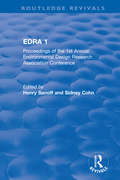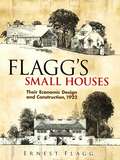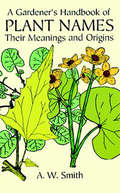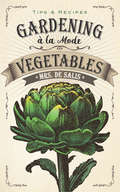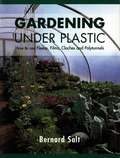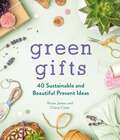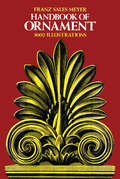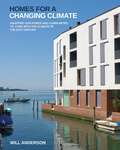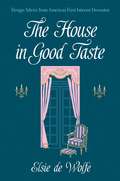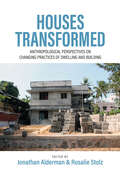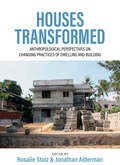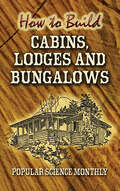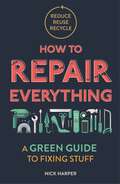- Table View
- List View
Detached house with garage (UEB uncontracted)
This image shows a front view of a detached house with attached garage. There is a locator dot shown, which will be at the top left of the page when the image is the right way up. The pointed tiled roof of the house fills the upper part of the page, with a chimney sticking up towards the right. Down from the roof the upstairs windows are shown: a large one towards the right and a smaller one to its left. Just to the left of the smaller window, the tiled garage roof slopes down above the wide garage door which has a handle towards its lower centre. The door to the house itself is towards the centre at the bottom of the image. The door is glazed at the top, and the letterbox and door knob are shown. There is a narrow window adjoining the door on the garage side. A large window is shown in the lower right of the image, and all the windows have sills.
Door Key (Large Print)
This picture is of a door key. There is a locator dot shown, which will be at the top left of the page when the image is the right way up. At the top is the handle of the key with a hole in it, and at the bottom is the part of the key that goes into the lock. On the left side of this are the pointed teeth and there is a groove going down to the right.
Door Key (UEB Contracted)
This picture is of a door key. There is a locator dot shown, which will be at the top left of the page when the image is the right way up. At the top is the handle of the key with a hole in it, and at the bottom is the part of the key that goes into the lock. On the left side of this are the pointed teeth and there is a groove going down to the right.
Door Key (UEB Uncontracted)
This picture is of a door key. There is a locator dot shown, which will be at the top left of the page when the image is the right way up. At the top is the handle of the key with a hole in it, and at the bottom is the part of the key that goes into the lock. On the left side of this are the pointed teeth and there is a groove going down to the right.
EDRA 1: Proceedings of the 1st Annual Environmental Design Research Association Conference (Routledge Revivals)
by Henry Sanoff Sidney CohnOriginally published in 1970, EDRA 1 is a record of the conference proceedings of the 1st annual Environmental Design Research Association conference. The papers featured in this volume represent the proceedings of the conference and are concerned mainly with contributions of scientific disciplines towards the creation of improved methods of problem-solving environmental design, as well as understanding the nature of human responses to the environment. The papers included in this volume focus on developing models and methods towards a framework of coherence and definable structure of environmental design, with the ultimate objective of achieving an optimum environment for man. This volume will be of great interest to planners, architects and academics of urbanisation alike. Although published over 40 years ago, the book’s content is still as relevant and interesting today as it was at the time of publication.
EDRA 1: Proceedings of the 1st Annual Environmental Design Research Association Conference (Routledge Revivals)
by Henry Sanoff; Sidney CohnOriginally published in 1970, EDRA 1 is a record of the conference proceedings of the 1st annual Environmental Design Research Association conference. The papers featured in this volume represent the proceedings of the conference and are concerned mainly with contributions of scientific disciplines towards the creation of improved methods of problem-solving environmental design, as well as understanding the nature of human responses to the environment. The papers included in this volume focus on developing models and methods towards a framework of coherence and definable structure of environmental design, with the ultimate objective of achieving an optimum environment for man. This volume will be of great interest to planners, architects and academics of urbanisation alike. Although published over 40 years ago, the book’s content is still as relevant and interesting today as it was at the time of publication.
The English Folly: The Edifice Complex
by Gwyn Headley Wim MeulenkampIf this were a novel, the tales of astounding wealth, sexual perversion, murder, munificence, rape, insanity, brutality, slavery, religious mania, selfishness, snobbery, charity, suicide, generosity, theft, madness, wickedness, failure and eccentricity which unfold in these pages would be too concentrated to allow for the willing suspension of disbelief. All these sins and virtues, and more, are displayed by the characters in this book, some exhibiting several of them simultaneously. Folly builders were not as we are. They never built what we now call follies. They built for beauty, utility, improvement; it is only we, struggling after them with our imperfect understanding, who dismiss their prodigious constructions as follies. Follies can be found around the world, but England is their spiritual home. Having written the definitive books on follies in Great Britain, Benelux and the USA, Headley & Meulenkamp have turned their attention to the folly builders themselves, people so blinded by fashion or driven by some nameless ideology that they expended great fortunes on making their point in brick, stone and flint. Most follies are simply misunderstood buildings, and this book studies the motives, characters, decisions and delusions of their builders. If there was madness in their building, fortunately there was no method in it.
The Erotic Word: Sexuality, Spirituality, And The Bible
by David M. CarrHistorically, the Bible has been used to drive a wedge between the spirit and the body. In this provocative book, David Carr argues that it can--and should--do just the opposite. Sexuality and spirituality, Carr contends, are intricately interwoven: when one is improverished, the other is warped. As a result, the journey toward God and the life-long engagement with our own sexual embodiment are inseparable. Humans, the Bible tells us, both male and female, were created in God's image, and eros--a fundamental longing for connection that finds abstract good in the pleasure we derive from the stimulation of the senses--is a central component of that image. The Bible, particularly the Hebrew Bible, affirms erotic passion, both eros between humans and eros between God and humans. In a sweeping examination of the sexual rules of the Bible, Carr asserts that Biblical "family values" are a far cry from anything promoted as such in contemporary politics. He concludes that passionate love--our preoccupaton therewith and pursuit thereof--is the primary human vocation, that eros is in fact the flavoring of life.
Flagg's Small Houses: Their Economic Design and Construction, 1922
by Ernest FlaggA celebrated New York architect and designer of the city's fabled Singer Building, Ernest Flagg (1857-1947) was most famous for his skyscrapers. But Flagg was also an ardent proponent of the well-designed single-family dwelling. As this classic treatise illustrates, he devised a variety of structural economies and ingenious innovations.Filled with 526 blueprints, photographs, and other illustrations, Flagg's Small Houses embraces modular designs, the use of ridge-dormers, and saving space, materials, and costs. Flagg offers advice on every corner of the home, from the practicalities of plumbing and heating to the aesthetics of color choices and landscaping designs. Modern designers, both professional and amateur, will find this book a timeless source of advice and inspiration.
A Gardener's Handbook of Plant Names: Their Meanings and Origins
by A. W. SmithFirst compact dictionary to combine definitions of botanical names in general usage with information on their derivation and guides to pronunciation. A monumental index provides a cross-reference from some 1,800 common plant names to corresponding botanical ones. Combines thoroughness, botanical rigor, and interesting facts and lore — all leavened with touches of humor.
Gardening à la Mode: Vegetables
by Harriet Anne De SalisWhat's the best way to protect vegetables from frost? How do you dry herbs and banish slugs? There's much to learn about making the most of your backyard vegetable garden, and this handy little guide is brimming with advice for novice gardeners. Written by a popular magazine columnist of the nineteenth century, these timeless suggestions offer straightforward guidance for every step of the way, from planting, watering, and fertilizing to cooking and preserving your homegrown produce.Author Harriet Anne de Salis was an expert at counseling Victorian housewives on the domestic arts, writing commonsense manuals for everything from cooking on a budget to raising poultry and training dogs. This companion volume to Gardening à la Mode: Fruits features alphabetized entries and an index for easy reference. Even seasoned gardeners and cooks are likely to find it a source of useful hints and enduring charm.
Gardening Without Irrigation: or Without Much, Anyway
by Steve SolomonHighly informative book on gardening in arid areas.
Green Gifts: 40 Sustainable and Beautiful Present Ideas
by Rosie James Claire CaterFrom homemade spa-day pamper products to gorgeous homewares, these 40 eco-gifting ideas will show you how to create presents from everyday household items. Whether you're eco-conscious and keen to reduce your plastic usage or want to be more sensible with your spending, this gorgeous craft compendium provides step-by-step guides to produce gifts that don't compromise on design or quality. Presents for sustainable living Home-grown plants and succulents from cuttings Self-care treatsOn-the-go necessities Special occasions Presents for furry loved ones … as well as tips and tricks on creating your own wrapping paper and gift tags, and much more besides. You'll be able to create modest yet striking products from items in your home and reward friends and family with carefully made contemporary treats. And by replacing disposable presents with recycled, eco-friendly ones that have been hand-made from materials in your home, you'll be saving your pennies while saving the world. The ultimate guide to eco-living and giving.
Handbook of Ornament: A Grammar Of Art, Industrial And Architectural Designing In All Its Branches, For Practical As Well As Theoretical Use (classic Reprint) (Dover Pictorial Archive Ser.)
by Franz Sales MeyerRepublished unabridged from the final comprehensive edition, this work contains the largest single-volume collection of classical art motifs ever compiled. It reproduces material from Greek and Roman, medieval European, Islamic, Renaissance, baroque, and early nineteenth-century art, architecture, and design — in all, presenting artists, crafters, and students with more than 3,000 designs.Featured design elements include networks, Gothic tracery, geometric designs, akanthos leaves, lotus ornamentation, animal ornamentation, grotesque figures, fret bands, chains, interlacements, rosettes, undulations, spirals, link borders, cresting borders, finials, crockets, gargoyles, foliations, panels, repeated ornaments, and hundreds of other elements. Other plates show decorated pottery vases, religious utensils, weapons, furniture, lamps, jewelry, and other artifacts, in addition to heraldic motifs and ornamental letters.
Homes for a Changing Climate: Adapting Our Homes and Communities to Cope with the Climate of the 21st Century
by Will AndersonAn exploration into the history of our collective response to the challenges of extreme weather conditions and climate.At the beginning of the twenty-first century, the world finally woke up to the reality of climate change and began the arduous task of freeing itself from dependence on fossil fuels. But the time lag in the Earth's ecosystem is such that our best efforts to cut carbon today will make little difference to the changing climate of the next 30 years. As we work towards a secure, low-carbon future, we must address the changes that are already taking place in the planet's climate. We must learn to live with higher temperatures, intense rainstorms, rising sea levels and prolonged drought. We must also confront the secondary impacts of climate change, especially on energy and food security.Britain has a mild, temperate climate where occasional weather extremes tend to have serious impacts because we are simply not prepared for them. Yet across the world, communities have been living with such extremes for millennia. If we have the imagination to learn from others and rethink the ways we build and live together, we can face this unsettling future with confidence.Homes for a Changing Climate celebrates this collective wisdom, exploring traditional and contemporary responses to the challenges of climate and illustrating the many ways in which houses can be designed, built and adapted to cope with these challenges. Examples are drawn from across Europe including the supervolcano of Thera, the 100mph winds of the Western Isles, and the cutting-edge eco-building projects in Britain. Based on the climate projections for the UK published by the Met Office in June 2009, Homes for a Changing Climate combines inspiring case studies, striking photography and practical advice to create a book of imagination and hope in uncertain times.
The House in Good Taste: Design Advice from America's First Interior Decorator (Dover Architecture)
by Elsie De Wolfe"Good taste can be developed in anyone, just as surely as good manners are possible to anyone. And good taste is as necessary as good manners," declared Elsie de Wolfe, the "first lady" of American interior design. Although de Wolfe decorated the homes of wealthy, socially prominent clients, she always maintained that her vision of elegant but comfortable living is attainable to all. This timeless 1913 book, written in a friendly, conversational tone, explains how to design, furnish, and decorate a house in order to make it a beautiful, useful, and livable home.De Wolfe pioneered the concept of the home as a representation of the owner's identity, and this book defines her decorating methods, philosophy, and approach to creating spaces for gracious entertaining. Part step-by-step manual and part aesthetic treatise, this volume advocates for simpler yet more refined decor. In contrast to the Victorian penchant for dark furniture, bric-a-brac, and heavy draperies, de Wolfe advised her readers to let in natural light, to replace gaudy colors with beige and ivory, and to abandon clutter. Her practical suggestions, illustrated by period photographs, illuminate the attitudes of a century ago while retaining their resonance for modern-day interior designers.
Houses Transformed: Anthropological Perspectives on Changing Practices of Dwelling and Building
by Rosalie Stolz Jonathan AldermanOver the decades, there has been a world-wide transformation of so-called ‘vernacular houses’. Based on ethnographic accounts from different regions, Houses Transformed investigates the changing practices of building houses in a transnational context. It explores the intersection of house biographies and social change, the politics of housing design, the social fabrication of aspirational houses, the domestication of concrete and the intersection of materiality and ontology as well as the rhetoric of the vernacular. The volume provides new anthropological pathways to understanding the dynamics of dwelling in the 21st century.
Houses Transformed: Anthropological Perspectives on Changing Practices of Dwelling and Building
Over the decades, there has been a world-wide transformation of so-called ‘vernacular houses’. Based on ethnographic accounts from different regions, Houses Transformed investigates the changing practices of building houses in a transnational context. It explores the intersection of house biographies and social change, the politics of housing design, the social fabrication of aspirational houses, the domestication of concrete and the intersection of materiality and ontology as well as the rhetoric of the vernacular. The volume provides new anthropological pathways to understanding the dynamics of dwelling in the 21st century.
How to Build Cabins, Lodges and Bungalows
by Popular Science Monthly"Nothing could be more American than the simple cabin. Not many generations ago, it was the backbone of American life, the headquarters of that important unit, the home. It provided shelter, protection, and a foundation upon which to build a great empire. The pioneer cabin was, in other words, a necessity." -- From the IntroductionOnce regarded as a safe haven and a vital source of security, the little cabin in the country is today more closely associated with leisurely activities -- a vacation spot and even a health investment. First published in the 1930s, this helpful guide was designed to provide vacation home builders with all the information they needed to construct, decorate, and furnish a rustic little cottage. Floor plans and outlines of necessary materials are included, as are tips on constructing foundations, porches, doors, windows, fireplaces, and other structural elements. There are even suggestions for furnishing and beautifying your cabin.A useful how-to manual, offering straightforward advice on the building process from foundation to roof, this practical book can also be enjoyed as an entertaining look at lifestyle elements of the early twentieth century.
How to Repair Everything: A Green Guide to Fixing Stuff
by Nick HarperWith advice on tools, materials and methods and written in an easy-to-follow, step-by-step format, this is a book that makes it easier to say ‘NO’ to our disposable society and make a real difference.___________‘Covers a vast range of jobs and gives simple, clear instructions’ – Sunday Post‘Reminds us that there’s a solution for every problem’ – Glamour___________Not everything has built-in obsolescence – as this fantastically handy guide to fixing everyday objects proves! Whether you need to repair the strap of a favourite handbag or mend a leak in a washing machine, How to Repair Everything is packed full of tips and tricks of the trade for the person who likes to do-it-yourself. From quick fixes that will get you out of a jam to permanent solutions that make the item good as new, this is perfect for anyone who hates the throwaway society and would much rather refurb and recycle.Whether it’s a sweater that’s shrunk in the wash, a broken umbrella spoke or fixing a microwave oven, you’ll be amazed just how many things can be mended with a few tools and a bit of patience.

